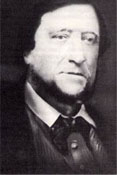- 01: Introduction
- 02: History
- 03: Propellants, Firearms, and Ammunition Development
- 04: Modern Firearms Manufacture
- 05: Small Arms Ammunition
- 06: Evidence Handling Procedures
- 07: Equipment and Instrumentation
- 08: Examination of Firearms
- 09: Cartridge and Shotshell Examination
- 10: Characterization and Evaluation of Fired Projectiles
- 11: Bullet Comparison and Identification
- 12: Gunshot Residue and Distance Determination
- 13: Toolmark Identification
- 14: Communicating Results
- Resources


1800s
Home > History > 1800s
1835

Henry Goddard
The earliest known toolmark comparison case involving firearms occurred in 1835 in London, England. A homeowner was shot and killed, and the servant was suspected of the crime. Henry Goddard, one of the Bow Street Runners (an early London police force), investigated the case.
By thorough examination of the physical evidence, Goddard was able to identify a visible flaw in the fired projectile and trace the mark to the manufacturer’s mold. He also identified the paper patch used to provide a seal between the projectile and the gunpowder as having been torn from a newspaper that was found in the servant’s quarters.
1852

A firearms-related examination occurred when an Oregon sheriff examined a hole in a homicide victim’s shirt to determine if it was caused by a bullet. The sheriff, using the suspect firearm and victim’s shirt, conducted experiments by test firing the weapon into the shirt. Subsequently, the sheriff testified in court that the hole in the shirt was caused by a bullet (not a tear); the suspect was convicted and hanged for murder.
1857

Human skull with
bullet wounds
Monsieur Noilles of Paris published the first work describing wounds resulting from small caliber firearms.
1863

Stonewall Jackson
During the United States Civil War, Confederate General Stonewall Jackson sustained three gunshot wounds at the Battle of Chancellorsville on May 2, 1863. A bullet removed from his right hand was examined and identified as a .67 caliber ball projectile from a smooth bore musket. Because the Union Army used the .58 caliber Minnie ball projectile in their rifles, it was concluded that Jackson had been shot by Confederate soldiers. Jackson died of complications eight days later.
1864

General John Sedgwick
Union General John Sedgwick was killed in battle by a single projectile fired by a Confederate sniper from an estimated distance of eight hundred yards. When the fatal bullet was removed from his body, a determination of bullet type was made based on the caliber and hexagonal shape of the bullet. This particular caliber and shape of bullet was consistent with the Whitworth rifles imported from England by the Confederate forces.
1876

A Georgia State Court allowed a witness, experienced in the use of firearms, to provide expert testimony concerning the amount of time elapsed since a gun was last fired.
1896

One of the first recorded instances of testimony regarding the effects of test firing occurred in a Kansas State Court. The court permitted the witness, experienced in the use of firearms, to conduct various experiments using the evidence pistol and similar cartridges in an attempt to determine the effect of firing at human hair and paper targets at close distances.




